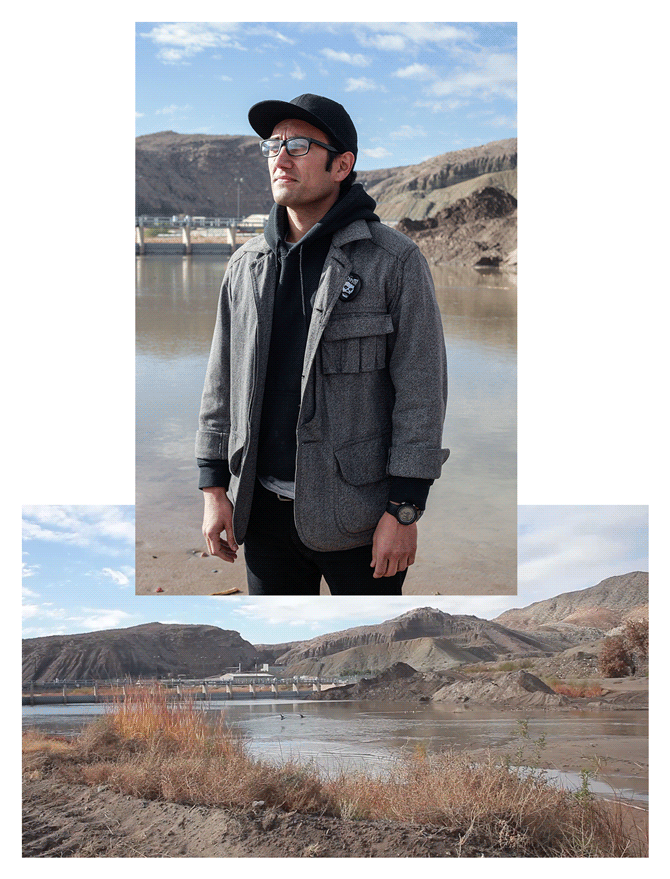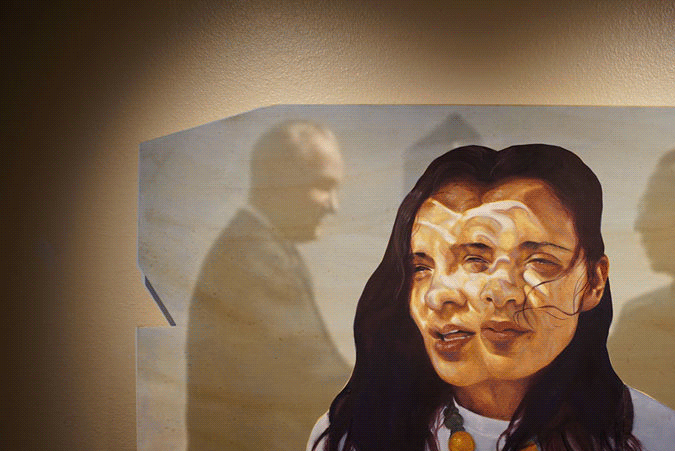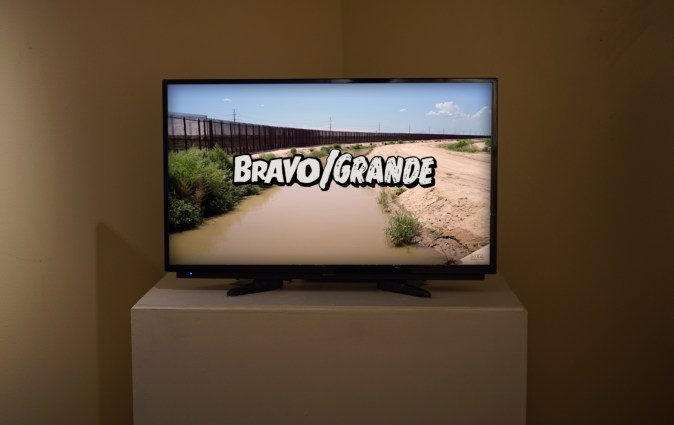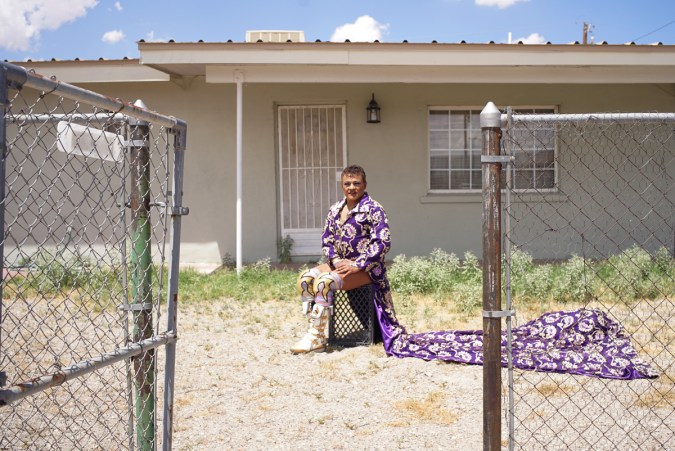It’s a warm winter day, and multimedia artist Zeke Peña and I are cruising pass I-10 to get to the American Diversion Dam in El Paso, Tejas. The dam sits less than 500 feet away from the US-Mexico border, an international hot topic due to Trump’s executive order to build a wall not unlike the one that spreads through the occupied West Bank. As we get out of the car and walk towards the Rio Grande, we see large construction machinery, a parked border patrol car, ducks leaving the scene and a loud helicopter circling the area. After flowing through the American Diversion Dam and crossing Colorado and New Mexico, the river itself becomes the border. But as Peña explains it, “[the river] didn’t make a good boundary marker because [it] was fluid and fluctuated literally from month to month and year to year” in the border region. So, in 1964 President Lyndon Baines Johnson and President Adolfo López Mateos signed the Chamizal Convention, which stated that the Rio Grande would be channelized in the El Paso / Júarez region, basically controlling its flow through a channel paved with cement. This was only the beginning of the extensive infrastructure we now see at the US-Mexico barrier.
Zeke Peña’s multimedia and interactive project called Bravo/Grande explores the history of the Rio Grande/Rio Bravo, in order to understand the history of the border region, the militarization of the border, and the overall effects that this politically constructed border has on the people who inhabit the binational metropolitan area of El Paso-Júarez. Peña’s ongoing project includes paintings, a short doc, an audio piece made by local El Paso musician, Eureka the Butcher, photography, and interactive video augmentation to go with the paintings. Remezcla recently caught up with Peña to talk about his project Bravo/Grande and unpack the dense topic of the Rio Grande / Rio Bravo.

Growing up on the border you see art everywhere, from murals and graffiti to the kitsch decor that decorates a home. When was the first time you remember being moved by a piece of art?
There is a visual culture that exists here [El Paso/Júarez]. One of the strongest experiences that I had with art was with a Luis Jimenez’ sculpture. I was in fourth grade and we went on this field trip. It blew my mind, I had never seen anything like it. His work can be problematic with gender politics, but in terms of the craftsmanship, obviously it’s amazing. That was the first time I was like ‘Woah, this is not something you see everyday.’
We often associate the Rio Grande / Rio Bravo river as the place where the U.S and Mexico split. Can you talk to me a bit about your project Bravo/Grande which deals with the political, ecological, and cultural meaning of the river?
It’s rooted in oral history and people’s stories about the river. Their memories of the river on both sides. The ecological part of it, how the river has been managed, how it is not used – it’s been colonized, and definitely exploited as a resource. The river holds our history. Looking at the history of the border it’s inevitable that you look at the history of the river.
The older generation remembers the river when it had water. Today, no one has any recollection of it.
Growing up here I had no relationship with the river, no concept of it, no sense of it. We don’t have that relationship with it. The older generation remembers the river when it had water, when there were trees there, when people were crossing, people were swimming in it, people were living with it and literally two generations after that no one has any recollection of it, no one has any memory of it. That’s significant.
[This project] really asks a simple question: Why is that? Why is it that it’s changed in one to two generations? The border is young.
Bravo/Grande is primarily an oral history project. It’s about gathering people’s stories from Cd. Júarez and El Paso and Ysleta Pueblo, really trying to understand what people think about the river. Specifically how the border has had an impact on that relationship, [which is] something I am now referring to as the border effect. So what does the border effect do to our community’s relationship to the river. How does that border effect change the river itself and change the community’s relationship to the river.
Before 1848 El Paso del Norte was one city. The history of this area is one and the same with the river. People settled in this area because there was water here, pretty basic.

In this Bravo/Grande project you worked with paint, photo, audio, and video work. Why did you choose to use this multimedia method over sticking to one medium?
I call it transmedia or interdisciplinary, but it’s basically telling one story over many mediums. There is video, there is photography, there is written text, paintings, and I think that is how everything needs to be now. Everything is on multiple platforms, everybody is Tweeting, it’s got to be interactive, got to be engaging. Something that I think when working like that is about education and embracing the different ways people think. Some young people think visually some people think with audio, it’s really about embracing that when exhibiting work.
I chose transmedia to embrace the different ways people think.
You collaborated with different people on this, talk to me about the collaboration.
It’s a community project. Friends and collaborators help with the concept of the work. I am the one making the painting and doing a lot of the editing and putting a lot of time into the project but I think with this kind of work it’s good to decentralize the idea, decentralize the concept. It allows for a better end product because there are more people having input.

Your work really captures the contradictions and juxtapositions of living on the border. How do you approach analyzing the border and reflecting it in your work?
With the larger paintings specifically, I will have really intensive conversation when portraying people in them. It’s traditional storytelling. When you look historically, in the Americas all the storytellers are telling the stories of their community. They are part of that community, are following the lead of their community, and just trying to depict those narratives and those stories that are important to their community. So, trying to follow that model of working I think really helps when it is such a complex and dense thing.
The river is a very concrete, tactile thing. But the concept of the border is an abstract, arbitrary thing.
You have stated that Rio ≠ Frontera. Can you expand on this?
My family from New Mexico has been farming with the river for generations, for centuries, so there is a significant cultural connection, a significant part of my identity that is connected to the river and my family history. Growing up in El Paso, my conception was always that the river was the border, that those two things were synonymous, and I think that we don’t really question that. The river is a very concrete, tactile, significant, sacred thing and the concept of the border is an abstract arbitrary thing that was arbitrarily determined by a bunch of white dudes. How can people be engaged with this conception of the river if there is no memory of the river, no sense of it.
Luchador Cassandro El Exótico [interviewed for Bravo/Grande] talks about the tradition of his family going down to the river for birthday parties. He also told a story of one of his uncle dying in the river and being drowned in the river. That’s another part of it, how many remember people being swept away and drowning in the river? What respect and what reverence you must have for something that capable of taking life. There is power there, significance there.

What do you hope to see in border art?
It isn’t one thing, it’s not this one project, it’s not anyone’s single project but the unity of all of those projects happening simultaneously and supporting each other.
We’ve got to engage with young people because those are the people that are going to carry us forward. I see way more young people identifying now as being from the border, as being fronteriza/os, which is critical. I think that’s first and foremost because if you are not identifying with the area, then it’s not significant to you – so why would you care about anything?
One of the most exciting things is what is happening in Júarez, because it’s coming from a need and it’s coming from within. The border is this hot issue, although that shines a light on us, how is there a significant connection to the community? Trying to support each other in those efforts, it’s what I see already happening.




